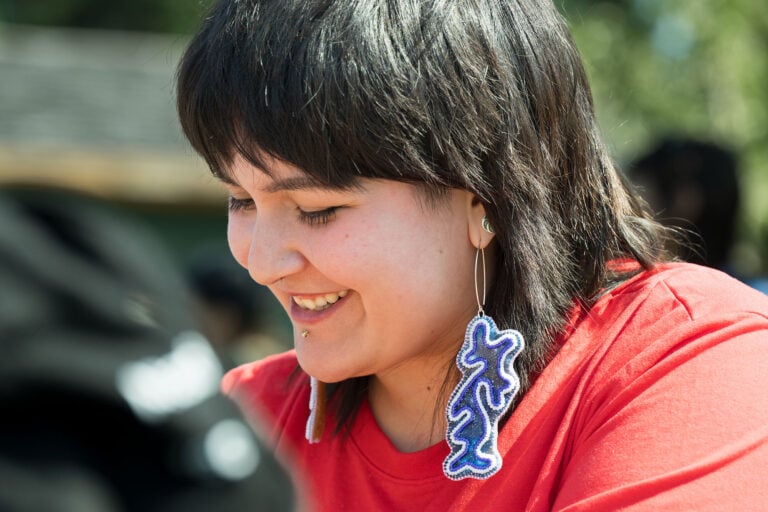
By Amy Kenny
Gukki Nuka is a private person. That’s why it’s a surreal experience for him to be approached by strangers when he’s in Greenland. Strangers who recognize his face and know the story of the sexual abuse he faced as a child.
At the same time, Nuka put that story out there himself in 2016, when he showed Cracks in the Soul, an exhibition of self-portraits that Nuka says started as a kind of diary to help him work through his abuse.
Nuka, a ceramicist, never imagined showing the images, which depict his naked body in scarred, abstract landscapes, exposed, crumpled, making compelling eye contact. Now that he has, he’s proud of himself. The show has toured galleries (it will open at the Yukon Arts Centre on Dec. 5) and recently led to Nuka being featured in a documentary about sexual abuse. He’s also doing advocacy and educational work around the issue. He says it’s helped change the way people in Greenland and Denmark talk about sexual abuse.
“People had been very closed off to it because the issue was too difficult, or hard to talk about,” Nuka said over the phone from Copenhagen, where he lives. “They’d rather shut up and turn away. Little by little now, people know that if we don’t take the responsibility on our own shoulders (for addressing this), we’re not going to change anything.”
Nuka says he thinks the work resonates with so many people because of his approach.
“I’m a quiet person. I’m not this shouty, loud person,” he says.
“I always used myself and my story (in my work), but I always told the story in a hidden way and a way that only I knew about it,” he says. With Cracks in the Soul, that story is front and centre without being confrontational.
“The way I told it was with respect for my fellow human beings. I’m not trying to stuff it down your throat, but I have to respect it … I’m not trying to confront you. It’s more like I’m trying to show you that there’s a light at the end of the tunnel.”
For Nuka, that light came prior to the original exhibition of the show at Greenland’s Nuuk Art Museum. At the time, he was in a good relationship and had gotten to a positive point with help from a psychologist. He felt ready to share, though he was still nervous about the concept. He was amazed by the turnout (it was a record-setting opening for Nuuk) and even more so by the support he felt.
That’s what he wants to give others through his work – the sense that they’re not alone if they’re suffering and the idea that speaking about it can help.
“They look at me and they think ‘if you can, I can.’ And I’m so proud of that.”
“I’ve grown a lot from this experience … I used to say it’s like I’ve grown 10 centimetres. It’s given me so much strength and the support from people has made me tougher also and not as fragile as I used to be. There are so many things in place inside me now, it’s not hard for me to openly talk about it anymore. I can communicate it in the best way I can with people who are taking the first step.”
Nuka’s exhibition will show in the main gallery at YAC alongside a new work from Yukon artist, Marten Berkman.
Berkman’s show, Remote Sensibility VIII: The Ecology of Perception, is a collaboration between a number of seemingly unlikely co-creators, including visual artists, choirs, scientists, astronauts and Elders.
The result is a 3D video and sound piece that ruminates on the concept of land through a combination of visual art, music and performance.
It’s not the first collaborative work Berkman has engaged in, but it may have the largest cast, with 27 individuals, including writer Kate Harris, former astronaut Julie Payette and Na-Cho Nyak Dun elder, Jimmy Johnny. The Whitehorse Chamber Choir and Toronto’s Elmer Iseler Singers add an additional 36 voices.
“This is something very special for me,” says Berkman. “I have been asked so often to contribute visual creation for performing artists in theatre and music and those elements combined just sing with me … the work I have seen of others and when I have worked with others has inspired me. Its been like each piece of work was another phrase in a larger whole that was aching to be realized.”
He wanted to tap into that for Remote Sensibility VIII, which he calls “a visual and auditory symphony inspired by the land.”
Berkman has been thinking about connections to land for a while, particularly about how in what he calls “his culture” (“I mean a western, urban, industrial society,” he says), there’s still an argument about how much people should care for the land.
“To me, there’s no question,” he says. Berkman hopes non-Indigenous cultures can learn to listen to First Nations communities in that respect, particularly when it comes to the idea that we’re all in this together, no matter where we live. He says he’s grateful for the participation of local Elders who contributed to the exhibition.
“That’s a perspective that people in the North have that can be medicine for the world because the land is such a powerful presence in our lives.”
Both shows run at YAC from Dec. 5, 2019 to Feb. 22, 2020.
In the community gallery, Sandra Storey’s A Long Goodbye: My Mother Had Alzheimer’s, also opens on Dec. 5. It is a series of ten sculptures that depicts the stages of the disease her mother succumbed to.
There will be an opening reception for all three exhibits on Dec. 5, 5:30pm – 7:30pm. Everyone is welcome to attend.


